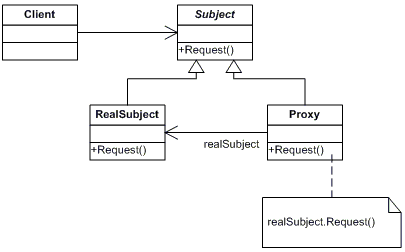Definition
Provide a surrogate or placeholder for another object to control access to it.
Explanation
A proxy, in its most general form, is a class functioning as an interface to something else. The proxy could interface to anything: a network connection, a large object in memory, a file, or some other resource that is expensive or impossible to duplicate.
In situations where multiple copies of a complex object must exist, the proxy pattern can be adapted to incorporate the flyweight pattern in order to reduce the application’s memory footprint. Typically, one instance of the complex object and multiple proxy objects are created, all of which contain a reference to the single original complex object. Any operations performed on the proxies are forwarded to the original object. Once all instances of the proxy are out of scope, the complex object’s memory may be deallocated.
The proxy design pattern allows you to provide an interface to other objects by creating a wrapper class as the proxy. The wrapper class, which is the proxy, can add additional functionality to the object of interest without changing the object’s code. Below are some of the common examples in which the proxy pattern is used:
- Adding security access to an existing object. The proxy will determine if the client can access the object of interest.
- Providing interface for remote resources, such as web service or REST resources.
- Coordinating expensive operations on remote resources by asking the remote resources to start the operation as soon as possible before accessing the resources.
- Adding a thread-safe feature to an existing class without changing the existing class’s code.
In short, the proxy is the object that is being called by the client to access the real object behind the scene.
Screencast
TypeScript Code
module Proxy {
interface ICalculator {
value: number;
add(value: number): number;
subtract(value: number): number;
multiply(value: number): number;
reset(): void;
}
class Calculator implements ICalculator {
private _value: number = 0;
public get value(): number {
return this._value;
}
public add(value: number): number {
return this._value += value;
}
public subtract(value: number): number {
return this._value -= value;
}
public multiply(value: number): number {
return this._value *= value;
}
public reset(): void {
this._value = 0;
}
}
/*Adds logging to the Calculator*/
class CalculatorProxy implements ICalculator {
private _calculator: Calculator = new Calculator();
public get value(): number {
return this._calculator.value;
}
public add(value: number): number {
Output.WriteLine("Start adding " + value + ".");
var result = this._calculator.add(value);
Output.WriteLine("Finished adding " + value + ".");
this.logValue();
return result;
}
public subtract(value: number): number {
Output.WriteLine("Start subtracting " + value + ".");
var result = this._calculator.subtract(value);
Output.WriteLine("Finished subtracting " + value + ".");
this.logValue();
return result;
}
public multiply(value: number): number {
Output.WriteLine("Start multiplying by " + value + ".");
var result = this._calculator.multiply(value);
Output.WriteLine("Finished multiplying by " + value + ".");
this.logValue();
return result;
}
public reset(): void {
Output.WriteLine("Start resetting");
this._calculator.reset();
Output.WriteLine("Finished resetting");
this.logValue();
}
private logValue(): void {
Output.WriteLine("The value of the calculator now is: " + this._calculator.value);
}
}
window.addEventListener("load", function () {
var calculator: ICalculator = new CalculatorProxy();
calculator.add(3);
calculator.subtract(1);
calculator.multiply(4);
Output.WriteLine("The value of the calculator is: " + calculator.value);
});
}
Output
